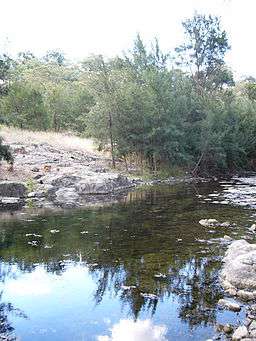Turon River
| Turon River | |
| Perennial stream | |
 The Turon River from near Sofala during a very dry season. | |
| Name origin: Aboriginal: Kamilaroi or Wiradjuri words choorun or yooran, the meaning of which is unknown[1] | |
| Country | Australia |
|---|---|
| State | New South Wales |
| Regions | South Eastern Highlands (IBRA), Central West |
| Municipalities | Lithgow, Mid-Western, Bathurst |
| Part of | Macquarie River, Murray–Darling basin |
| Tributaries | |
| - right | Crudine River |
| Source | Capertee Valley |
| - location | near Ben Bullen |
| - elevation | 778 m (2,552 ft) |
| - coordinates | 33°13′55″S 149°58′23″E / 33.23194°S 149.97306°E |
| Mouth | confluence with the Macquarie River |
| - location | near Hill End |
| - elevation | 406 m (1,332 ft) |
| - coordinates | 33°5′10″S 149°23′25″E / 33.08611°S 149.39028°ECoordinates: 33°5′10″S 149°23′25″E / 33.08611°S 149.39028°E |
| Length | 117 km (73 mi) |
 Location of the Turon River mouth in New South Wales | |
| [2] | |
Turon River, a perennial stream[1] that is part of the Macquarie catchment within the Murray–Darling basin, is located in the central western district of New South Wales, Australia. Partly situated in the Turon National Park,[3] the river is host to numerous recreational and tourist activities such as horseback riding, gold panning, canoeing, camping, and seasonal fishing.
Geography
The Turon River rises on the western slopes of the Great Dividing Range in the Capertee Valley, west of Ben Bullen, and flows generally to the north west and then west, joined by the Crudine River, and then forms its confluence with the Macquarie River south west of Hill End; dropping 372 metres (1,220 ft) over the course of its 117 kilometres (73 mi) length.
The upper reaches of the Turon River are partly bound by Turon National Park, established in 2002, while the lower reaches open onto private grazing property.
Gold rush
The Turon River is well renowned because it was the site of one of Australia's first alluvial gold rushes.[4] During the gold rush Chinese migrant workers built a water race to bring water to mining operations along sections of the Turon River. Many parts of the race can still be seen today, such as at Turon Gates.[5] The Turon River was the site of violence between miners and licensing authorities during the gold rush.
See also
References
- 1 2 "Turon River". Geographical Names Register (GNR) of NSW. Geographical Names Board of New South Wales. Retrieved 25 January 2013.
- ↑ "Map of Turon River". Bonzle.com. Retrieved 25 January 2013.
- ↑ "Turon National Park". nationalparks.nsw.gov.au. Retrieved 27 December 2015.
- ↑ "Mining Heritage - Profile 3 - Alluvial Gold". Australian Heritage Council. Retrieved 11 November 2007.
- ↑ "Turon Gates Country Retreat". Turon Gates. 2009. Retrieved 25 January 2013.
External links
- "Macquarie-Bogan River catchment" (map). Office of Environment and Heritage. Government of New South Wales.